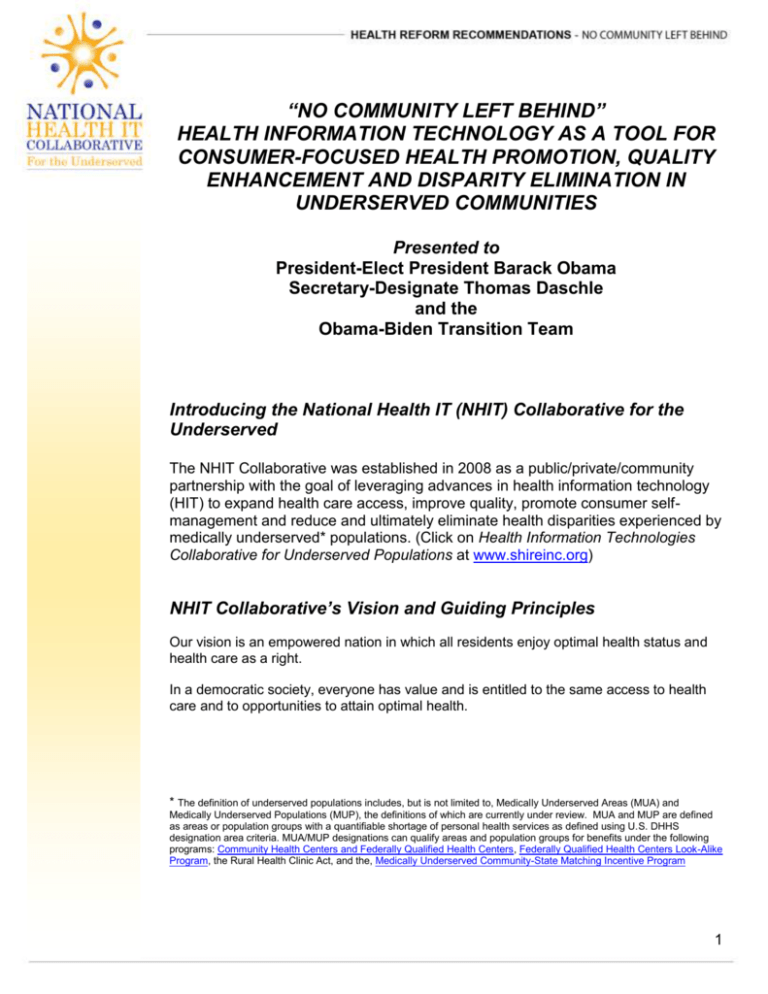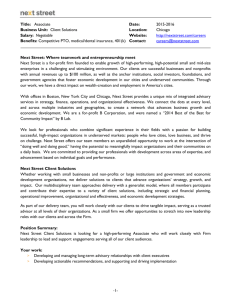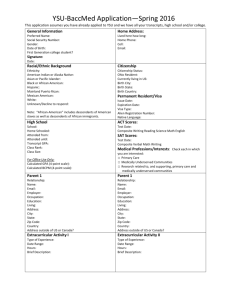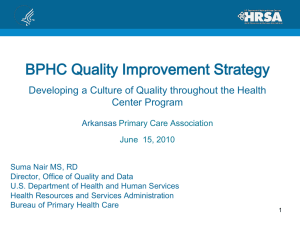health_care_reform-and-hit
advertisement

“NO COMMUNITY LEFT BEHIND” HEALTH INFORMATION TECHNOLOGY AS A TOOL FOR CONSUMER-FOCUSED HEALTH PROMOTION, QUALITY ENHANCEMENT AND DISPARITY ELIMINATION IN UNDERSERVED COMMUNITIES Presented to President-Elect President Barack Obama Secretary-Designate Thomas Daschle and the Obama-Biden Transition Team Introducing the National Health IT (NHIT) Collaborative for the Underserved The NHIT Collaborative was established in 2008 as a public/private/community partnership with the goal of leveraging advances in health information technology (HIT) to expand health care access, improve quality, promote consumer selfmanagement and reduce and ultimately eliminate health disparities experienced by medically underserved* populations. (Click on Health Information Technologies Collaborative for Underserved Populations at www.shireinc.org) NHIT Collaborative’s Vision and Guiding Principles Our vision is an empowered nation in which all residents enjoy optimal health status and health care as a right. In a democratic society, everyone has value and is entitled to the same access to health care and to opportunities to attain optimal health. * The definition of underserved populations includes, but is not limited to, Medically Underserved Areas (MUA) and Medically Underserved Populations (MUP), the definitions of which are currently under review. MUA and MUP are defined as areas or population groups with a quantifiable shortage of personal health services as defined using U.S. DHHS designation area criteria. MUA/MUP designations can qualify areas and population groups for benefits under the following programs: Community Health Centers and Federally Qualified Health Centers, Federally Qualified Health Centers Look-Alike Program, the Rural Health Clinic Act, and the, Medically Underserved Community-State Matching Incentive Program 1 Health reform must rest on the premise that every citizen must be engaged and included by way of processes that reach them where they are – from the “grass-roots” to the “treetops.” Appropriate education/outreach strategies, public policies, workforce development/training efforts; and finance and sustainability initiatives must be made available as essential tools, along with health information technology, in order to achieve improved health quality, and these tools must benefit all. Overview of Recommendations We propose HIT as an essential element of a reformed medical intervention system, as well as an indispensable requirement for a health promotion/disease prevention infrastructure that supports underserved consumers in taking charge of their health. Key components are: 1. Expanded broad-band access in rural and other underserved communities; 2. Medical homes for all U.S. residents that are HIT-equipped and linked; 3. Incentives, including grants, revised reimbursement and coding policies, etc. to promote adoption of HIT by health providers in underserved communities; 4. Community networks of neighborhood health coaches/navigators equipped with HIT and assigned to help underserved consumers access health care and adopt personal wellness strategies; 5. HIT workforce development and training to advance health reform and economic stimulus initiatives; 6.Culturally and linguistically appropriate social marketing, education and outreach programs that inform providers and consumers in underserved communities of HIT benefits and uses with respect to expanded access, quality improvement and consumer health management; 7. Support for pilot projects that demonstrate creative uses of innovative and/or existing information technology that can be effective in underserved communities; 8. National HIT adoption goals that are tailored to and inclusive of diverse socio-economic, racial/ethnic and other population groups; 9. White House-level leadership for HIT, personal wellness/physical fitness and community engagement in health care reform. 2 Recommended Policy Options The NHIT Collaborative stands ready to work with the Obama Administration in offering recommendations pursuant to these nine policy areas – proposals that include, but are not limited to, the following: 1. Expanded broadband access Recommendations Support expansion of the Federal Communications Commission’s Rural Health Care Pilot Program to bring communication infrastructure into rural and underserved areas – an essential precursor to the use of electronic medical records, telemedicine and local/regional interoperability. Promote free access to electronic health information by individuals hampered by the “digital divide,” (e.g., using public libraries to promote access to medical records through Internet access without degrading secure channels). Consider communities with empowerment zones that have underutilized capacity to underwrite bonds for broadband development. 2. HIT-equipped medical homes for all U.S. residents Recommendations Qualify physician and nurse-managed practices that meet certain standards as medical homes, as well as community health centers and other entities, and establish grant/loan programs for qualified practices/entities to secure and use EHRs to enhance efficiency and consumer engagement and education. Assure availability of funds for medically underserved areas that receive HRSA resources for HIT-supported patient-focused and collaborative health care. Provide infrastructure for expanded community health center (CHC) sites to encourage and support appropriate and authorized information-sharing, with particular emphasis on CHC, free clinics and public health facility cooperation. 3. Incentives to promote adoption by providers Recommendations Provide incentives through grants, low-cost loans, demonstration projects and other means to assist providers in underserved areas, in recognition of their lower rates of compensation and more limited access to financial resources; Provide for exceptions to government mandates requiring HIT adoption by providers based on location, patient mix and other factors; Provide grants and other incentives to establish Health IT Action Zones that demonstrate effective practices for promoting the adoption of Health IT by individuals from vulnerable populations, as 3 well as by providers who care for patients who are medically underserved and are impacted by health and/or digital disparities. Compensate health providers for on-line and in-person wellness promotion and prevention counseling by modifying existing coding and reimbursement strategies. 4. Neighborhood health coaches/navigators Recommendations Include health coaches/navigators in Obama Administration’s job creation initiative as entry-level health workforce employment opportunities Utilize community-based organizations and faith institutions as partners to recruit, train and assign coaches/navigators to at-risk consumers among their constituents to prevent unnecessary emergency room use and hospitalizations. Consider Community Development Block Grants as a source of support for these services. 5. HIT workforce development Recommendations Address high unemployment rates in underserved communities by training workers to install and service electronic health records (EHRs), personal health records (PHRs) and other forms of HIT, and to provide technical assistance to providers and consumers regarding their use. Make grants available to medical homes to train current medical and administrative personnel in HIT to increase efficiency and enhance adoption. 6. Culturally and linguistically appropriate social marketing, education and outreach programs. Recommendations Develop culturally/linguistically targeted and community-focused social marketing programs to promote HIT adoption, engaging community and ethnic media partners; consider effective techniques employed in tobacco control, underage drinking, seat belt use, and child car seat campaigns. Utilize and promote the use of the national standards for culturally and linguistically appropriate services (CLAS) as adopted and promulgated by the Office of Minority Health Support outreach efforts to promote HIT adoption by acquainting diverse communities with HIT utilization options, benefits, and privacy safeguards, utilizing activities and strategies that are culturally appropriate and engage, to the fullest extent possible, community stakeholders in the development, execution and evaluation of such efforts. 4 7. Demonstrations of creative uses of innovative and/or existing information technology Recommendations Support studies of “promising/best practices” and fund demonstration projects involving use of cell phones, Podcasts, kiosks, “smart cards” and other devices that can be used for transmitting health information, and assess impacts of use on consumer health outcomes. Identify pilot communities (e.g. New Orleans) as proving grounds for “promising/best practices” and demonstrations that have potential to close health gaps and improve the quality of health care services. 8. Targeted national HIT adoption goals Recommendation Require the collection of data that are disaggregated by race, ethnicity, primary language, socio-economic status and other indicators that will inform the establishment of HIT adoption goals for diverse population groups 9. White House-level leadership Recommendations Establish an Office of HIT Awareness, Education, and Advocacy (OHAEA) at the highest level possible to signify the importance of this effort to the growth and prosperity of the country, and establish linkages through OHAEA with each State and all relevant national stakeholders to deploy initiatives and advocate for increased adoption of HIT at all levels. Strengthen and expand the President’s Council on Physical Fitness as a means to promote health, wellness and active living at the national level to help create a climate fostering receptivity to HIT adoption and widespread use. For more information, contact: Program Management Office , National Health IT Collaborative for the Underserved, 1776 Massachusetts Avenue, NW., Suite 615, Washington, DC 20036-1904. Phone: 202-371-0277; Fax: 202-452-8111: Email: shire@shireinc.org; Website: www.shireinc.org – click on Health Information Technologies for Underserved Populations. 5





